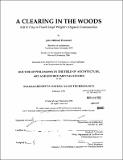| dc.contributor.advisor | Stanford Anderson. | en_US |
| dc.contributor.author | Desmond, John Michael | en_US |
| dc.date.accessioned | 2005-08-18T12:00:00Z | en_US |
| dc.date.available | 2005-08-18T12:00:00Z | en_US |
| dc.date.copyright | 1995 | en_US |
| dc.date.issued | 1996 | en_US |
| dc.identifier.uri | http://hdl.handle.net/1721.1/11235 | |
| dc.description | Thesis (Ph. D.)--Massachusetts Institute of Technology, Dept. of Architecture and Planning, 1996. | en_US |
| dc.description | Includes bibliographical references (p. 583-601). | en_US |
| dc.description | Vita. | en_US |
| dc.description.abstract | This dissertation undertakes a comparative and developmental analysis of Frank Lloyd Wright's community scale planning projects executed in the wake of Broadacre City during the decade of the Second World War (1938 - 1948). These include the Sun-Top Homes built in Ardmore Pennsylvania, the Usonia I project for East Lansing Michigan, the Pittsfield Worker Housing project designed for western Massachusetts, the master plan for Circle Pines summer camp in central Wisconsin, and three partially built circular lot subdivisions, Galesburg Country Homes near Galesburg Michigan, Parkwyn Village in Kalamazoo Michigan, and Usonia Homes in Pleasantville New York. Through this study of seven planning projects Wright's thinking can be seen moving from a tradition of viewing the settlement as a 'constructed whole' to a design philosophy that approached nature as an a-priori, all embracing context. In these works he explored the relationship of the natural to the manmade by inventing patterns which allow neither the site nor the geometry of the plan to assume cognitive priority. One's perception of the relationship between the individual and the group comes to be crossed with one's perception of the character of the landscape in ways that extend an American hermeneutical tradition of self and landscape into the modem era. Building on the method of Emerson, and especially on the explorations of Thoreau and Whitman, Wright sought to redefine the ever-present tension between the individual and the democratic group in terms of a symbolic interaction of self and landscape that lies at the heart of the American myth of nature. His involvement with self, with nature, and with perceptions of community as indicated here suggests an alternative to traditional American suburban models, as well as to the European inspired hOUSing ideas coming into this country in the post-war period. | en_US |
| dc.description.statementofresponsibility | by John Micahel Desmond. | en_US |
| dc.format.extent | 604 p. | en_US |
| dc.format.extent | 56369493 bytes | |
| dc.format.extent | 56369245 bytes | |
| dc.format.mimetype | application/pdf | |
| dc.format.mimetype | application/pdf | |
| dc.language.iso | eng | en_US |
| dc.publisher | Massachusetts Institute of Technology | en_US |
| dc.rights | M.I.T. theses are protected by copyright. They may be viewed from this source for any purpose, but reproduction or distribution in any format is prohibited without written permission. See provided URL for inquiries about permission. | en_US |
| dc.rights.uri | http://dspace.mit.edu/handle/1721.1/7582 | |
| dc.subject | Architecture | en_US |
| dc.subject | Urban Studies and Planning | en_US |
| dc.title | A clearing in the woods : self & city in Frank Lloyd Wright's organic communities | en_US |
| dc.title.alternative | Frank Lloyd Wright's organic communities | en_US |
| dc.type | Thesis | en_US |
| dc.description.degree | Ph.D. | en_US |
| dc.contributor.department | Massachusetts Institute of Technology. Department of Architecture | |
| dc.contributor.department | Massachusetts Institute of Technology. Department of Urban Studies and Planning | |
| dc.identifier.oclc | 34777595 | en_US |
